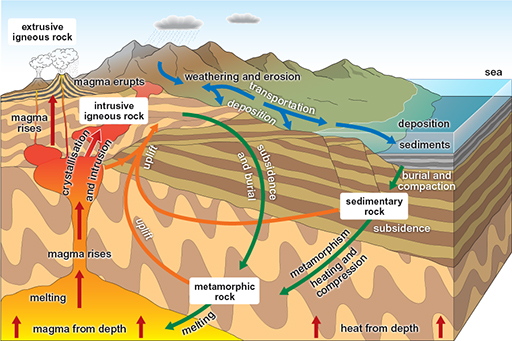1.6 The rock cycle and plate tectonics
Ever wondered why mountains are found in certain places on the Earth and not others? In this section you will learn about how the Earth recycles rocks and how this affects the Earth’s crust.
The rock cycle – one turns into another
You have already tried to identify rocks that are used in your local area as either igneous, sedimentary or metamorphic, but have you ever thought about how rocks end up in these categories? Or, if rocks are broken down into clasts, will we ever run out of rock to form sedimentary rocks with? Luckily, the answer to the last question is no – this section will investigate how rocks change between these three categories. It is described by a conceptual system called the ‘rock cycle’ and one of the main processes involved is plate tectonics. These two topics are what you’ll be studying for the rest of this week.
All three sorts of rocks are continually being created, modified and destroyed by many different geological processes, operating at all scales of both length and time. This can be a single crystal grain decomposing during weathering, to the ocean being formed as a result of the long strings of volcanoes that exist along the ocean floors (more on that later). A good way of viewing how different types of rock may be connected by processes that form and re-form them is through a conceptual system known as the rock cycle.
The rock cycle not only sets the three main groups of rocks into a spatial context, it also links them through processes of formation and transformation.
Processes that take place at the surface of the Earth include weathering, transportation and deposition, as well as biological processes such as the growth of some of the animals and their shells or skeletons, which form parts of sedimentary rocks.
Inside the Earth, processes include burial and subsidence, which may lead to metamorphism as pressure and heat builds up, and then potentially to melting and the first step to forming the next igneous rock.
As you can see in the diagram, there are many routes around the rock cycle. The most direct route through the cycle is probably:
- An igneous rock is weathered and eroded, the bits are transported somewhere where they build up to form sediments. These undergo burial and are compacted to form a sedimentary rock.
- The sedimentary rock is heated during deep burial. The heat and pressure may first form a metamorphic rock, but this may never see the surface of the earth before it is melted to form a magma – hot liquid rock.
- The magma rises up and cools, forming a new igneous rock, and the cycle starts again.
Can you find any of the other routes around the rock cycle?

